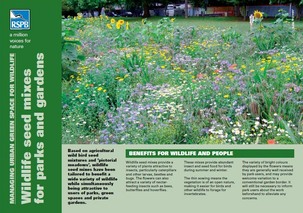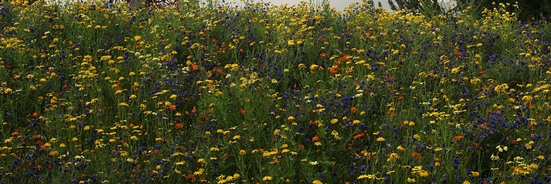

Biodiversity
Action
Plan
Now available as either annual or perennial mixes, these modern ‘meadow’ seed mixes have been designed to bring more colours and a longer flowering season than the traditional grassland meadows, often using non-native species to do it. They do not have the grasses that can out-compete desirable flowering plant species.
And they can be designed to support a wide range of wildlife. Often the flowers attract nectar feeding insects such as bees, butterflies and hoverflies. The seed mixes can provide plants that support insects and other invertebrates in their different life stages, including those that control pests. Having larval food plants in the mix or nearby will expand the range of invertebrates supported.
Seed mix planting can provide insect and seed food for birds during summer and winter. In fact some wildlife flower seed mixes are based on agricultural wild bird seed mixtures in order to provide vital food for seed-eating birds throughout winter. [see RSPB advice note]
Thin sowing gives vegetation of an open nature, making it easier for birds and mammals to forage. The planted area(s) can be relatively small: in domestic garden a couple of square metres is worthwhile, or even a window box! In parks and green spaces the areas needn’t be large to be of benefit to wildlife. Birds are most likely to benefit if the seed mix is planted close to shrubs or a hedgerow used for foraging and shelter.
Seed mixes can be treated like other flowering garden plants - they don’t need to grow in poor soils where the topsoil has been removed.; most seed mixes are best grown however in sunny locations. Spring sowing (late March through April) is recommended although watering and weeding may sometimes be necessary. The thing that is essential is that the ground is carefully prepared and that any grass or weeds are removed. [see suppliers advice]
This useful RSPB advice note on Wildlife Seed Mixes for parks and gardens is in the RSPB’s Urban Advice Pack
Look up the Pictorial Meadows approach, developed in Sheffield, on their website.
Other suppliers can also provide both advice and materials.
Look out for: Wildlife seed mix, Wildlbird seed mix, Butterfly and bee seed mix, Pollinators seed mix, and many more.
Traditional grassland wild flower meadows, a priority habitat, can also be created in parks and gardens. See the flower-rich amenity grassland page in this biodiversity plan.
Please note:
Commercial ‘wild flower seed mixes’ and/or plants (which may contain non-natives or be of unknown provenance) should not be sown in the wider country-side or close to environmentally sensitive areas.
Seed mix planting. Planting colourful ‘meadow’ seed mixes in parks, gardens and along urban roads has become popular in recent years. These ‘pictorial meadows’ are often quite spectacular and can also help wildlife. The variety of bright colours displayed may provide a welcome alternative to the usual flower bed.


Seed Mix Planting